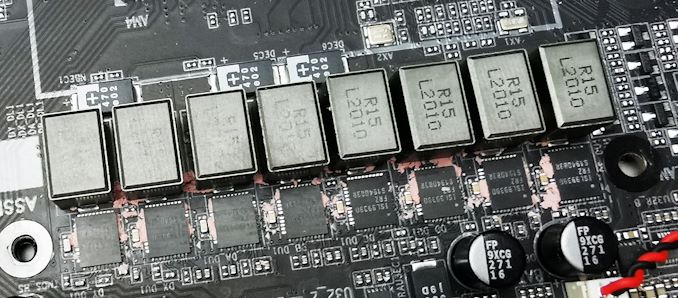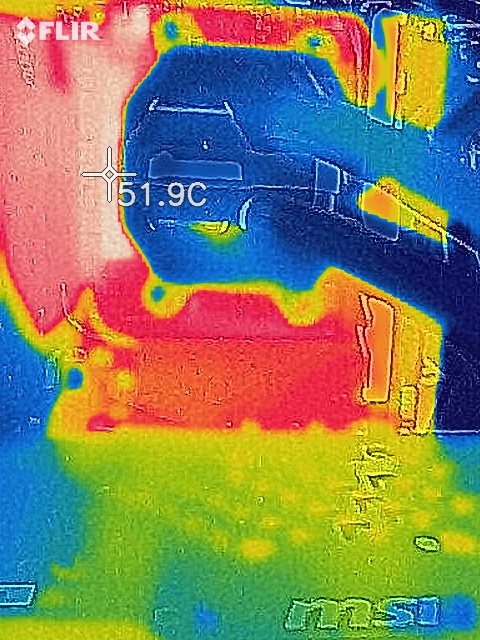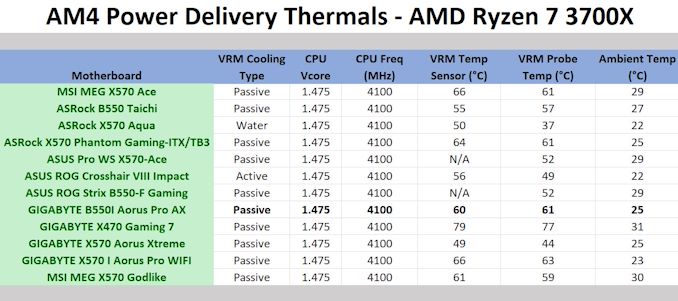The GIGABYTE B550I Aorus Pro AX Motherboard Review: All The Small Things
by Gavin Bonshor on December 7, 2020 10:00 AM ESTPower Delivery Thermal Analysis
One of the most requested elements of our motherboard reviews revolves around the power delivery and its componentry. Aside from the quality of the components and its capability for overclocking to push out higher clock speeds which in turn improves performance, is the thermal capability of the cooling solutions implemented by manufacturers. While almost always fine for users running processors at default settings, the cooling capability of the VRMs isn't something that users should worry too much about, but for those looking to squeeze out extra performance from the CPU via overclocking, this puts extra pressure on the power delivery and in turn, generates extra heat. This is why more premium models often include heatsinks on its models with better cooling designs, heftier chunks of metal, and in some cases, even with water blocks.

The 8-phase power delivery operating at 6+2 on the GIGABYTE B550I Aorus Pro AX
Testing Methodology
Out method of testing out if the power delivery and its heatsink are effective at dissipating heat, is by running an intensely heavy CPU workload for a prolonged method of time. We apply an overclock which is deemed safe and at the maximum that the silicon on our AMD Ryzen 7 3700X processor allows. We then run the Prime95 with AVX2 enabled under a torture test for an hour at the maximum stable overclock we can which puts insane pressure on the processor. We collect our data via three different methods which include the following:
- Taking a thermal image from a birds-eye view after an hour with a Flir Pro thermal imaging camera
- Securing two probes on to the rear of the PCB, right underneath CPU VCore section of the power delivery for better parity in case the first probe reports a faulty reading
- Taking a reading of the VRM temperature from the sensor reading within the HWInfo monitoring application
The reason for using three different methods is that some sensors can read inaccurate temperatures, which can give very erratic results for users looking to gauge whether an overclock is too much pressure for the power delivery handle. With using a probe on the rear, it can also show the efficiency of the power stages and heatsinks as a wide margin between the probe and sensor temperature can show that the heatsink is dissipating heat and that the design is working, or that the internal sensor is massively wrong. To ensure our probe was accurate before testing, I binned 10 and selected the most accurate (within 1c of the actual temperature) for better parity in our testing.
For thermal image, we use a Flir One camera as it gives a good indication of where the heat is generated around the socket area, as some designs use different configurations and an evenly spread power delivery with good components will usually generate less heat. Manufacturers who use inefficient heatsinks and cheap out on power delivery components should run hotter than those who have invested. Of course, a $700 flagship motherboard is likely to outperform a cheaper $100 model under the same testing conditions, but it is still worth testing to see which vendors are doing things correctly.
Thermal Analysis Results

We measured 51.9°C on the hottest part of CPU socket area during our testing
The GIGABYTE B550I Aorus Pro AX is using an 8-phase design that operates in a 6+2 configuration. It consists of six Intersil ISL99390 90 A power stages for the CPU VCore, and two ISL99390 90 A power stages for the SoC. (insert doubler). Cooling the power delivery is a large single heatsink that molds into the design of the board's plastic rear panel cover and is connected to the M.2 and chipset heatsink. It relies primarily on brute mass and good passive airflow within a chassis.
Looking at the GIGABYTE B550I Aorus Pro AX's power delivery thermal results in comparison to other AM4 models we've tested with our Ryzen 7 3700X processor, it performs pretty well all things considered. We typically see higher temperatures on mini-ITX motherboards which is a direct result of cramped componentry on a small PCB. Where an ATX size model can utilize PCB space to split power deliveries into two elements with one to two heatsinks to dissipate the heat more effectively, the GIGABYTE power delivery operates in a single strip with a single heatsink doing all of the heat removal.
We observed a reading of 61°C from our first K-type probe on the rear, with our second consistent with a slight variance of 59°C. This is also consistent with the reading from the board's VRM temperature sensor of 61°C, which shows the heatsink is efficiently removing heat as our thermal imaging camera shows the hottest part around the socket reached just shy of 52°C. This is good for a mini-ITX model and it shows GIGABYTE has another highly efficient power delivery design on its hands.











76 Comments
View All Comments
Grabo - Tuesday, December 8, 2020 - link
I've had this board since summer, currently on the latest firmware. No complaints, except the disappearing bluetooth. Sometimes it's there, mostly it isn't. Dual booting linux and windows and it's the same in both. I acquired a usb bluetooth adapter as soon as I read about others having the same issue with this board.mkarwin - Tuesday, December 15, 2020 - link
Seems like using the BT for key/mouse wireless device is out of the question in this case then?R3MF - Tuesday, December 8, 2020 - link
I have this board, been great.Fujikoma - Tuesday, December 8, 2020 - link
The owner's guide is pretty skimpy. There were no instructions or visuals for installation of the NVME drives, which I found very odd because the top side spacer screw threw me for a moment. It may seem dumb, but I'm a stickler for reading instructions before installing even simple things. Very much enjoyed seeing this article, since I bought this board for my wife to use for lite gaming.Dug - Tuesday, December 8, 2020 - link
For the love of everything motherboards, please go back to or start testing the components on the motherboard. Wifi, ethernet, sound, memory, storage of m.2 front and back, sata, bluetooth, USB. These are the things that make or break a consumer buying a motherboard.All the testing you do, just says it runs some benchmarks. That's great, but unless a motherboard fails (I haven't seen a review yet that a motherboard fails to run your tests), then it's not really helping us.
How about clearance for popular heatsinks.
And why do you insist on measuring non uefi boot times? It's a waste of your time and everyone else.
Gigaplex - Tuesday, December 8, 2020 - link
Fair comment, I did have some clearance issues with this board for heatsinks. Even the stock Wraith Stealth needed the plastic shroud to be rotated 90 degrees to fit on this board.Gigaplex - Tuesday, December 8, 2020 - link
This is a weird time to post a review like this for this board. It has been out for a while, and has been solid for most of that time. However with the Zen 3 enablement BIOSes, there's been a lot of issues.6YearsLater - Tuesday, December 8, 2020 - link
Why didn't anandtech do graphis card reviews?biatch0 - Wednesday, December 9, 2020 - link
I recently got this exact board and am happy with it overall - other than the Bluetooth requiring a complete power off and disconnect from PSU in order to work regularly... but apparently that's a B550 issue?Grabo - Wednesday, December 9, 2020 - link
That may indeed be the case, am reading about the same issue for several brand B550 boards now. Back when I got this board in the summer I only found references to it. But yes, there was the unplug psu and replug advice then too, which does always work, but it isn't very handy when the psu is built into the chassis (nr200)..so I got an aptx usb bt adapter which always shows up. Software wise one just needs to handle the ax200 bt when it does randomly decide to show up (which it does sometimes, even if you don't unplug the psu).